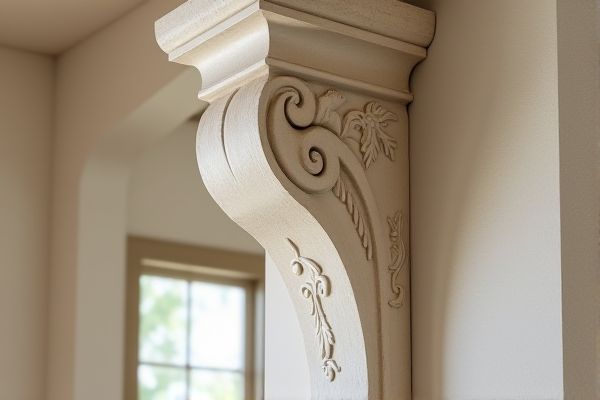
Decorative corbels primarily enhance architectural aesthetics without bearing structural load, while functional brackets support shelves, beams, or other weights, serving a practical purpose. Discover which option best suits your design needs by exploring the detailed distinctions in the rest of this article.
Table of Comparison
| Feature | Decorative Corbel | Functional Bracket |
|---|---|---|
| Purpose | Primarily ornamental, enhances aesthetic appeal | Structural support for shelves, countertops, or beams |
| Material | Wood, plaster, resin, or composite for design flexibility | Metal, wood, or heavy-duty material for strength |
| Load-bearing Capacity | Minimal to none, mostly visual | High, designed to support weight and stress |
| Design | Intricate, ornate shapes and moldings | Simple, practical, often angular or triangular |
| Installation | Surface mounted, no need for structural fastening | Anchored securely into studs or wall frame |
| Typical Use Cases | Architectural embellishments, decorative niches, mantelpieces | Shelf support, countertop reinforcement, stair stringers |
Understanding Decorative Corbels and Functional Brackets
Decorative corbels are architectural elements primarily designed to enhance aesthetic appeal, often featuring intricate carvings and historical styles that complement various interior and exterior designs. Functional brackets serve a structural purpose by supporting shelves, countertops, or overhangs, ensuring stability and load-bearing capacity while often having simpler designs focused on practicality. Understanding the distinction between decorative corbels and functional brackets helps in choosing the right element to balance both beauty and utility in construction and design projects.
Key Differences Between Corbels and Brackets
Decorative corbels primarily serve an aesthetic purpose, often crafted from wood, stone, or plaster to enhance architectural style without bearing significant weight. Functional brackets are structural components designed to support loads such as shelves, countertops, or roof eaves, typically made from metal or heavy-duty materials. The key difference lies in their utility: corbels emphasize ornamental design, while brackets provide essential support and stability.
Historical Uses of Corbels and Brackets
Corbels and brackets have historically served distinct architectural roles, with corbels primarily used in ancient stone construction to support arches, beams, and balconies, often intricately carved to reflect artistic styles of the period. Functional brackets emerged prominently in medieval timber-framed buildings, providing structural support for overhanging elements such as upper floors and eaves while being simpler in design. Over centuries, both elements evolved to incorporate decorative motifs, blending structural necessity with ornamental appeal in Gothic, Renaissance, and Victorian architecture.
Materials Commonly Used for Each Type
Decorative corbels are often crafted from materials like wood, plaster, or polyurethane to enhance aesthetic appeal without bearing heavy loads. Functional brackets typically use stronger materials such as metal, wrought iron, or reinforced wood designed to support structural weight and provide stability. Your choice between these options depends on whether the primary goal is ornamentation or support in your project.
Aesthetic Appeal: Decorative Corbels in Interior Design
Decorative corbels enhance interior design by adding intricate, artistic details that elevate the visual appeal of shelves, mantels, and cabinetry. Unlike functional brackets, which prioritize structural support, decorative corbels serve primarily as ornamental features, often crafted from wood, plaster, or resin with elaborate patterns. Their use contributes to a classic or traditional aesthetic, creating focal points that blend functionality with timeless elegance in various architectural styles.
Functional Brackets: Supporting Weight and Structure
Functional brackets are engineered to support weight and provide structural stability in various applications, such as shelving, countertops, and overhangs. These brackets are typically made from robust materials like steel, wood, or cast iron to ensure durability and load-bearing capacity. Your choice of a functional bracket is crucial for maintaining safety and longevity in both residential and commercial construction projects.
Installation Considerations for Corbels and Brackets
Installation considerations for decorative corbels and functional brackets differ significantly due to their intended purposes. Decorative corbels typically require secure attachment to walls or cabinetry using screws and anchors, prioritizing aesthetic placement rather than load-bearing strength. Functional brackets demand more robust installation methods, including anchoring into wall studs or structural supports to safely bear weight, ensuring stability and durability.
Popular Applications in Modern Homes
Decorative corbels enhance the aesthetic appeal of kitchen islands, mantelpieces, and shelving units, adding a classic or ornate touch without bearing significant weight. Functional brackets are commonly used to support heavier loads such as countertops, wall-mounted desks, and outdoor awnings, providing structural stability where durability is essential. Understanding the difference helps you choose the right element to balance visual appeal with practical support in your modern home design.
Maintenance and Longevity Comparison
Decorative corbels generally require less maintenance than functional brackets since they bear no structural load, reducing the risk of damage from stress or wear. Functional brackets often need regular inspections and repairs to ensure they continue supporting weight safely, especially when exposed to outdoor elements. Using durable materials like steel or treated wood can enhance the longevity of functional brackets, while decorative corbels benefit from finishes that resist fading and moisture.
Choosing the Right Option for Your Project
Selecting between a decorative corbel and a functional bracket depends on your project's structural needs and aesthetic goals. Decorative corbels primarily enhance visual appeal without supporting significant weight, while functional brackets provide essential support for shelves, counters, or overhangs. Assessing the load requirements and design style ensures your project benefits from the right balance of functionality and decoration.
 homyna.com
homyna.com